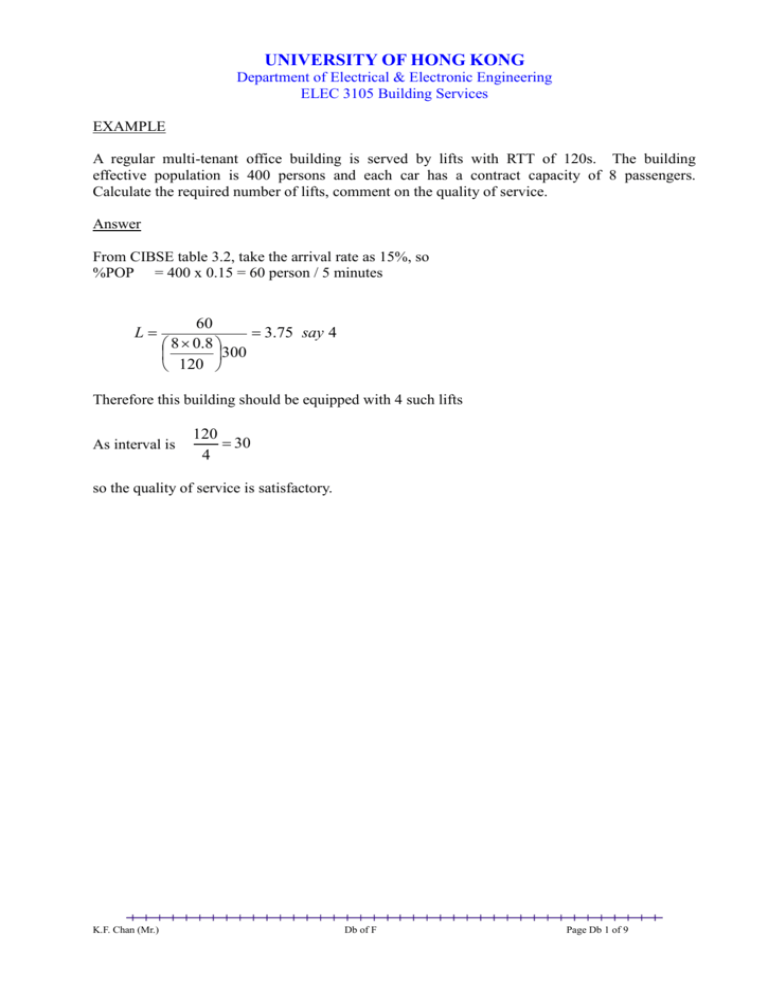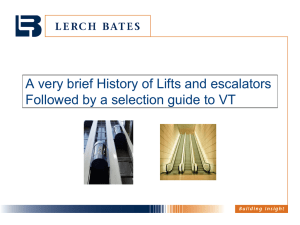Db intro to lift traffic analysis
advertisement

UNIVERSITY OF HONG KONG Department of Electrical & Electronic Engineering ELEC 3105 Building Services EXAMPLE A regular multi-tenant office building is served by lifts with RTT of 120s. The building effective population is 400 persons and each car has a contract capacity of 8 passengers. Calculate the required number of lifts, comment on the quality of service. Answer From CIBSE table 3.2, take the arrival rate as 15%, so %POP = 400 x 0.15 = 60 person / 5 minutes L 60 3.75 say 4 8 0.8 300 120 Therefore this building should be equipped with 4 such lifts As interval is 120 30 4 so the quality of service is satisfactory. K.F. Chan (Mr.) Db of F Page Db 1 of 9 UNIVERSITY OF HONG KONG Department of Electrical & Electronic Engineering ELEC 3105 Building Services Contract Speed Speed is generally not a dominant factor in the RTT equation but it does become significant if the served floors are in an upper zone where a higher speed will permit the un-served zone to be more rapidly traversed. Recommended Contract Speed Speed, m/s 0.25 to 0.4 0.50 0.63 1.0 1.6 2.5 5.0 Lift travel with J=0, m (number of floors) Building Usage Luxury flats Offices Bed lifts 5 10 (3) 10 15 (4) 15 (4) 20 (6) 20 (6) 20 25 (8) 32 (10) 45 40 (12) 50 (15) 100 100 (30) 100 (30) - There is no theoretical upper limit to lift rated speed and it does not affect passenger comfort. But it is limited by practical factors such as the maximum sheave diameter, rope-bending radius, rope wear, safety etc. Moreover, it is important to limit the acceleration to approximately 1.2 m/s² in order to provide a good ride quality. The HK Fire Services Department stipulates that all fireman lifts must be able to travel to the highest floor from the fire control entrance level in 60 seconds. Number of lifts A general rule of thumb for office building of floor area 1,000m2 per floor and arrival rate>15%, is :Good service Average service Poor service K.F. Chan (Mr.) One lift per 2 floors One lift per 3 floors One lift per 5 floors Db of F Page Db 2 of 9 UNIVERSITY OF HONG KONG Department of Electrical & Electronic Engineering ELEC 3105 Building Services Design sequence The design sequence for sizing a lift system for its uppeak performance is :a) Determine population per floor b) Determine if Express Lifts are required c) Select number of zones and their respective floors (suggest each zone serving 200 to 400 persons, and zones may have unequal number of floors) Then for each zone d) Find arrival rate, work out 5-minute uppeak demand. e) Find J f) Find N g) Select contract speed, acceleration, and deceleration. h) Select P i) Find H and S j) Use H/S as average jump (average flight) k) Calculate RTT l) Calculate 5-minute uppeak handling capacity per lift m) In conjunction with the 5-minute arrival rate, determine number of lifts, L n) Calculate the UPPINT and other parameters o) Counter check if UPPINT and %POP are within the recommendation of table 3.2 of CIBSE Guide D p) If meeting constraints and specification, proceed to other zones. If not OK, iteration. Finally q) Check if the capital and running costs are acceptable. K.F. Chan (Mr.) Db of F Page Db 3 of 9 UNIVERSITY OF HONG KONG Department of Electrical & Electronic Engineering ELEC 3105 Building Services Example on number of lifts A lift system is to be designed for a 20-storey high regular multi-tenancy office building. Area of each floor is 450m2, with interfloor height of 3.5m. It can be assumed that the occupancy is 9m2/person with daily occupancy of 90% only. What will be a suitable number of lifts? Answer 450 = 50 persons/floor 9 Total population is 50 x 20 = 1,000 persons Effective population is thus 1000 x 90% = 900 persons. There are Assume 15% arrival rate in the 5-minute peak (from CIBSE Guide D table 3.2) the arrival rate will thus be 900 x 15% = 135 persons / 5 minutes For average quality of service, UPPINT is 30 seconds. So there shall be minimum in the peak 5-minutes. Each trip is to take should be 300 = 10 trips 30 135 = 13.5 persons. Thus rated capacity 10 13.5 = 16.8, say 16 persons. 0.8 For average quality of service, there should be one lift per 3 floors, say 6 lifts in this building. Now from table 3.7 of CIBSE Guide D, for lift travel of 3.5 x 20 = 70m, let’s take contract speed as 3.15m/s with acceleration of 1m/s2. So initial design is 6 lifts each of 16 persons rated capacity, 3.15m/s contract speed and acceleration of 1m/s2. K.F. Chan (Mr.) Db of F Page Db 4 of 9 UNIVERSITY OF HONG KONG Department of Electrical & Electronic Engineering ELEC 3105 Building Services Remarks The standard lift traffic design uses the uppeak calculation, i.e. with only an up flow of passengers, to determine the likely performance of a lift system. It is generally accepted that if the uppeak traffic pattern is sized correctly all other traffic patterns with also be adequately served. (#) Fortunately it can be shown that a lift system possesses 50% more handling capacity during down peak than uppeak. This is because during down-peak a lift car fills at 3, 4 or 5 floors and then makes an express run to the main terminal. (#) Exceptions:- hotel at meal times, hospitals at visiting times, buildings with trading floors (insurance company, stock markets). Unequal interfloor distance In case of unequal floor distances, and if condition permits, the rule of thumb is to add together the incremental floor distances, extra to the standard interfloor height, multiply by 2 to account for both directions of travel, and divide by the rated speed to obtain the additional RTT. K.F. Chan (Mr.) Db of F Page Db 5 of 9 UNIVERSITY OF HONG KONG Department of Electrical & Electronic Engineering ELEC 3105 Building Services Example on RTT and number of lifts A multi-tenant prestige office has 50 floors above the ground floor. Each floor is 1000m2 in area. The daily occupancy rate is 90%. The ground floor has a height of 7m; height of 1st floor to 4th floor is 5m each. The 24th floor is a mechanical floor with a height of 3m only. Floor height of the other floors is all 3.5m. 36th to 50th floor are grouped into a high zone served by 4 lifts each of contract capacity of 16 persons, 8m/s contract speed, 1m/s2 acceleration and deceleration. The lift door is biparting type, 0.8m wide, advance opening control is employed. a. Calculate the round trip time, and the % population served in the 5-minute uppeak period with this lift installation. b. Are 4 lifts sufficient for this zone? If not, recommend number of lifts. Answer When no data is available, population can be estimated from table 3.1 of the CIBSE Guide D. In this case let us assume that the occupancy is 15m2 per person. With 90% daily occupancy rate, the occupancy per floor is 1000 0.9 60 15 The total population in the zone is thus 60x15=900pax Table 3.2 of CIBSE Guide D recommends that the arrival rate in the 5-minute uppeak period to be taken as 17%, so the handling capacity in that 5-minute uppeak period should not be less than 900x0.17=153pax a) The probable number of stops and highest reversal floor can be calculated by the following formula: P 1 S N 1 1 N 160.8 1 S 151 1 8.8 15 N 1 i H N i 1 N P For N=15, CC=16, H=14.3 from table 2.13 of CIBSE Guide D K.F. Chan (Mr.) Db of F Page Db 6 of 9 UNIVERSITY OF HONG KONG Department of Electrical & Electronic Engineering ELEC 3105 Building Services The floor to floor height from G/F up to 35th floor is 7 (G/F) + (4-1+1)x5 (1/F to 4/F inclusive) + (23-5+1)x3.5 (5/F to 23/F inclusive) + 3 (24/F) + (34-25+1)x3.5 (25/F to 34/F inclusive, meaning up to the floor level of 35/F) = 131.5m this is the distance between floor of G/F and floor of 35/F 131.5m is the distance the lift express travels before reaching the zone served. The unequal floor distance for G/F and 24th floor will be accounted for in the “time to jump to first stop” and in the “time to express return back to main terminal floor” in the calculation below. RTT = time to jump to first stop + time to jump from first stop to subsequent stops then to highest reversal floor + time to express return from highest reversal floor to main terminal floor + door operating times + passenger transfer times Now it is obvious that the lift is able to reach contract speed in the first jump because H J d f v S . Time to jump to first stop is a a H v J S d f v a 14.3 8 131.5 8.8 3.5 = 25.15s 8 1 Again, it is obvious that lift is unable to reach contract speed in subsequent jumps because K.F. Chan (Mr.) Db of F Page Db 7 of 9 UNIVERSITY OF HONG KONG Department of Electrical & Electronic Engineering ELEC 3105 Building Services H d f v S . Time for jumping subsequent stops is a a H df S 12 S a 14.3 3.5 = 37.2s 8.8 12 8.8 1 Furthermore, as the lift is able to reach contract speed in its jump to the first stop so it is more than obvious that the lift is able to reach contract speed in the return to main terminal floor (or we can check if v a J H d f a ). Time to express return to G/F is v J H d f v a 8 131.5 14.33.5 = 30.69s 8 1 From table 3.8 of CIBSE Guide D, the door opening and closing time can be taken as 0.5s and 2s respectively. Door operating times is thus S 1t o t c = 8.8 10.5 2 =24.5s Passenger loading and unloading time can be taken as 1.2s for each passenger according to CIBSE Guide D. Therefore, total passenger transfer time becomes Ptl tu = 16 0.81.2 1.2 = 30.72s Thus RTT = 25.15+37.2+30.69+24.5+30.72 =148.3s For 4 lifts, number of passengers served in the 5-minute uppeak period is 4 16 0.8 300 = 103pax 148.3 The percentage population served in the 5-minute uppeak interval is thus K.F. Chan (Mr.) Db of F Page Db 8 of 9 UNIVERSITY OF HONG KONG Department of Electrical & Electronic Engineering ELEC 3105 Building Services 103 = 11.5% 900 b) With 4 lifts, the number of passengers served during the 5-minute uppeak period is only 103pax. This is lower than the 153pax calculated above thus not acceptable. Furthermore, table 3.2 of CIBSE Guide D recommends an interval of 20 – 25s. With 4 lifts, the uppeak interval is 148.3 =37.1s, this is also considered to be longer than the recommended interval for a prestige 4 multi-tenant office. The number of lifts should be increased to 153 = 6 lifts 16 0.8 300 148.3 Moreover, with 6 lifts, the uppeak interval is reduced to 148.3 =24.7. This is within the 6 recommendation of 20 – 25s, thus acceptable. K.F. Chan (Mr.) Db of F Page Db 9 of 9






